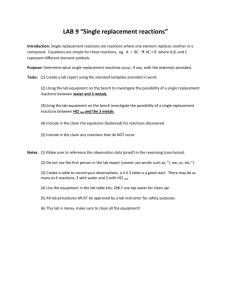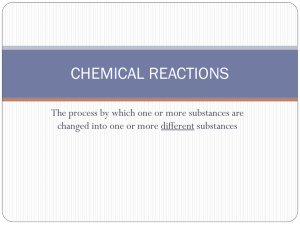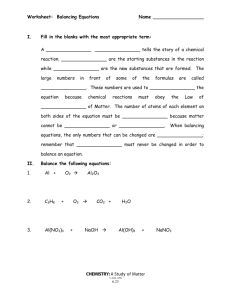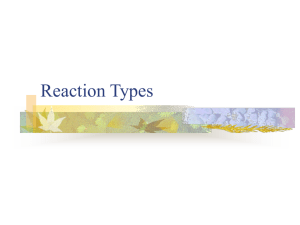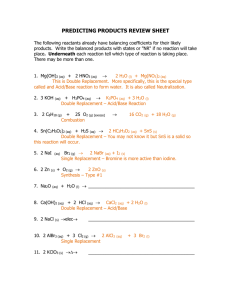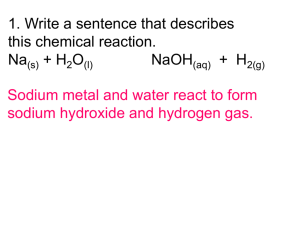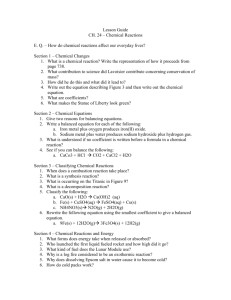Click here for Ch. 11 Study Guide
advertisement
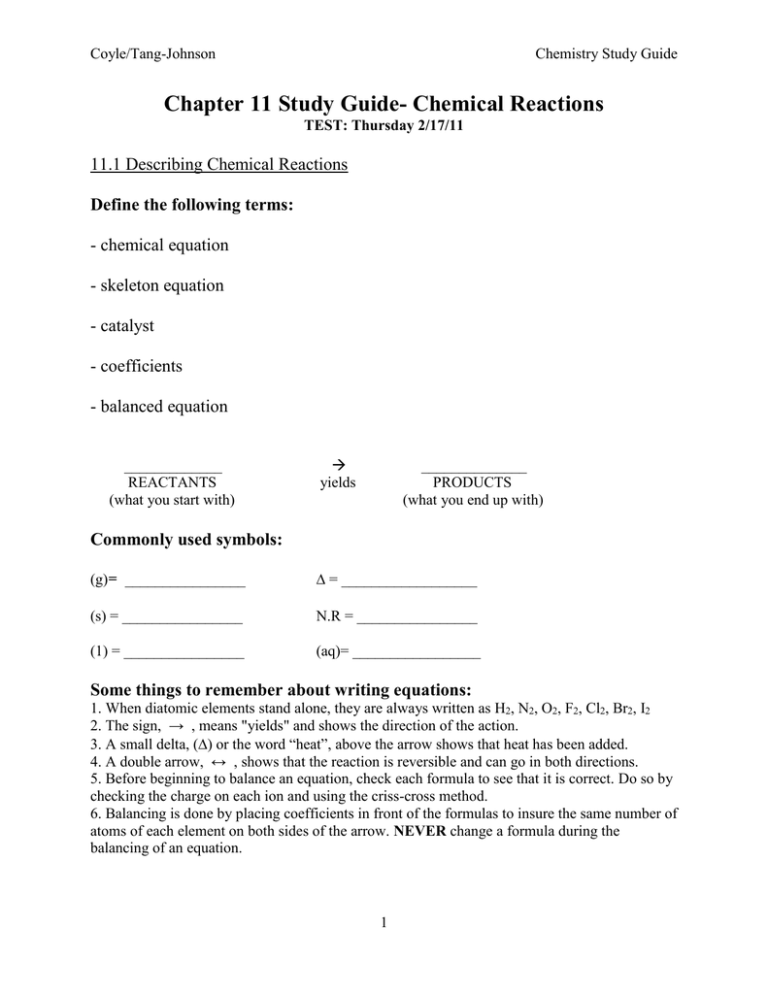
Coyle/Tang-Johnson Chemistry Study Guide Chapter 11 Study Guide- Chemical Reactions TEST: Thursday 2/17/11 11.1 Describing Chemical Reactions Define the following terms: - chemical equation - skeleton equation - catalyst - coefficients - balanced equation _____________ REACTANTS (what you start with) yields ______________ PRODUCTS (what you end up with) Commonly used symbols: (g)= ________________ = __________________ (s) = ________________ N.R = ________________ (1) = ________________ (aq)= _________________ Some things to remember about writing equations: 1. When diatomic elements stand alone, they are always written as H2, N2, O2, F2, Cl2, Br2, I2 2. The sign, → , means "yields" and shows the direction of the action. 3. A small delta, () or the word “heat”, above the arrow shows that heat has been added. 4. A double arrow, ↔ , shows that the reaction is reversible and can go in both directions. 5. Before beginning to balance an equation, check each formula to see that it is correct. Do so by checking the charge on each ion and using the criss-cross method. 6. Balancing is done by placing coefficients in front of the formulas to insure the same number of atoms of each element on both sides of the arrow. NEVER change a formula during the balancing of an equation. 1 Coyle/Tang-Johnson Chemistry Study Guide Rules for Balancing Equations: 1. Write the complete formula with the reactants on the left and products on the right. 2. Count the number of atoms of each element on each side of the equation. 3. Balance the number of atoms by adding coefficients (the number in front of the formula); do NOT change subscripts to balance. 4. Make sure all coefficients are in the lowest possible ratio. * Always leave the O2 or H2O for last * When balancing equations that have compounds with polyatomic ions, consider the polyatomic ion as a unit. * Always consult the Activity Series of metals and nonmetals before attempting to write equations for replacement reactions. * If a reactant or product is a solid, (s) is placed after the formula. * If a reactant or product is a gas, (g) is placed after it. * If a reactant or product is in water solution, (aq) is placed after it. PRACTICE: Rewrite the following word equations and balance them. 1. zinc + lead (II) nitrate yields zinc nitrate + lead 2. sodium phosphate + calcium chloride yields calcium phosphate + sodium chloride 11.2 Types of Chemical Reactions 1. Synthesis (Combination or Composition) A synthesis reaction is when there is a combination of two or more substances and a compound results. An example of a synthesis reaction is as follows: A + B AB 2. Decomposition Decomposition is the opposite of synthesis. It is when a compound is broken down into simpler substances, usually through electrolysis. An example of decomposition is as follows: AB A + B 2 Coyle/Tang-Johnson Chemistry Study Guide 3. Single Replacement In a single replacement reaction, there is a rule that is always followed. A metal replaces a metal, or a nonmetal replaces a nonmetal. An example of a single replacement reaction is as follows: A + BC AC + B *** For an element to replace another lone element, it must be more active than the element it is replacing. 4. Double Replacement Reactions In a double replacement reaction, this rule is always followed. A metal replaces a metal, and a nonmetal replaces a nonmetal. An example of a double replacement reaction is as follows: AB + XY AY + XB *** For a double replacement reaction to occur, at least ONE of the following must happen: 1. One precipitate is formed (an insoluble or slightly insoluble solid) Check the solubility chart on the back of the periodic table 2. A molecular compound is formed (usually H2O) 3. A gas is formed 5. Combustion A combustion reaction is when all substances in a compound are combined with oxygen, which then produces carbon dioxide and water. Combustion is commonly called burning. It is an exothermic reaction, which means heat is produced and is easily distinguished. Combustion occurs predominantly in automobiles, homes, and in factories. An example of a combustion reaction is as follows: CxHy + O2 CO2 + H2O 11.3 Reactions in Aqueous Solutions Define the following terms: - complete ionic equation - spectator ion - net ionic equation *** See p. 342 for an example of complete and net ionic equations *** 3 Coyle/Tang-Johnson Chemistry Study Guide MIXED PRACTICE: Identify the type and balance the following equations and determine whether the reaction will occur (Label precipitates and aqueous solutions for double replacement reactions) Cl2 1. AlBr3 + 2. NaOH + HCl 3. NaCl + AgNO3 4. C2H5OH 5. Zn + HCl 6. Ca + H2O → 7. ZnO + HCl → 8. CuSO4 9. Cu2S Br2 NaCl + H2O NaNO3 O2 + + AlCl3 + ZnCl2 + H2O + H2 Ca(OH) 2 + H2 ZnCl2 + Fe → + O2 CO2 + AgCl H2O Fe2(SO4)3 → Cu2O + Cu + SO2 10. C2H4 + O2 → CO2 + H2O 11. C2H4 + O2 → CO H2O 12. Zn + O2 → ZnO 13. Na2CO3 14. C4H8 (g) 15. BaCl2 (aq) 16. F2 (g) + → Na2O + + CO2 + O2 (g) + H2SO4 (aq) KCl (aq) 4 Coyle/Tang-Johnson Chemistry Study Guide Single Replacement Reactions Balance and Predict the following products (**Remember to use your Activity Series of Metals Chart**) MgCl2 (aq) → 1. Ni (s) + 2. Fe (s) + CuSO4 (aq) → 3. Br2 (aq) + KCl (aq) → 4. Al (s) + Fe2O3(s) → 5. Zn (s) + CuSO4(aq) → Double Replacement Reactions Balance and Predict the following products (**Remember to use your Solubility Chart**) 1. FeCl 2 (aq) + K 2S (aq) → 2. AlCl3 (aq) + Na 2CO3 (aq) → 3. ZnSO4(aq) + SrCl2 (aq) → 4. Pb(NO3) 2 (aq) + KI (aq) → 5. KCl(aq) + AgNO3(aq) → 5 Coyle/Tang-Johnson Chemistry Study Guide PRACTICE: a) Write the correct formula for each reaction, b) Balance the equation, and c) Label the type of reaction 1. sulfur trioxide and water combine to make sulfuric acid. 2. lead II nitrate and sodium iodide react to make lead iodide and sodium nitrate. 3. calcium fluoride and sulfuric acid make calcium sulfate and hydrogen fluoride 4. calcium carbonate will come apart when heated to leave calcium oxide and carbon dioxide. 5. ammonia gas when it is pressed into water will make ammonium hydroxide. 6. sodium hydroxide neutralizes carbonic acid 7. zinc sulfide and oxygen become zinc oxide and sulfur. 8. lithium oxide and water make lithium hydroxide 9. aluminum hydroxide and sulfuric acid neutralize to make water and aluminum sulfate. 10. sulfur burns in oxygen to make sulfur dioxide. 11. barium hydroxide and sulfuric acid make water and barium sulfate. 6 Coyle/Tang-Johnson Chemistry Study Guide 12. aluminum sulfate and calcium hydroxide become aluminum hydroxide and calcium sulfate. 13. copper metal and silver nitrate react to form silver metal and copper II nitrate. 14. sodium metal and chlorine react to make sodium chloride. 15. calcium phosphate and sulfuric acid make calcium sulfate and phosphoric acid. 16. phosphoric acid plus sodium hydroxide. 17. propane burns (with oxygen) 18. zinc and copper II sulfate yield zinc sulfate and copper metal 19. sulfuric acid reacts with zinc 20. acetic acid ionizes. 21. steam methane to get hydrogen and carbon dioxide 22. calcium oxide and aluminum make aluminum oxide and calcium 23. chlorine gas and sodium bromide yield sodium chloride and bromine 7 Coyle/Tang-Johnson Chemistry Study Guide ANSWERS TO EQUATIONS on p. 6 & 7 1. SO3 + H2O SYNTHESIS H2SO4 2. Pb(NO3)2 + 2NaI PbI2 + 2NaNO3 DOUBLE REPLACEMENT (lead II iodide precipitates) 3. CaF2 + H2SO4 CaSO4 + 2 HF DOUBLE REPLACEMENT (calcium sulfate precipitates) 4. CaCO3 CaO + CO2 DECOMPOSITION 5. NH3 + H2O SYNTHESIS NH4OH 6. 2 NaOH + H2CO3 Na2CO3 + 2 H2O DOUBLE REPLACEMENT OR ACID-BASE NEUTRALIZATION 7. 2 ZnS + O2 2 ZnO + 2 S SINGLE REPLACEMENT 8. Li2O + H2O SYNTHESIS 2 LiOH 9. 2 Al(OH)3 + 3 H2SO4 6 H2O + Al2(SO4)3 DOUBLE REPLACEMENT OR ACID-BASE NEUTRALIZATION 10. S + O2 SO2 SYNTHESIS 11. Ba(OH)2 + H2SO4 2 H2O + BaSO4 DOUBLE REPLACEMENT OR ACID-BASE NEUTRALIZATION 12. Al2(SO4)3 + 3 Ca(OH)2 2 Al(OH)3 + 3 CaSO4 DOUBLE REPLACEMENT (BOTH calcium sulfate and aluminum hydroxide are precipitate.) 13. Cu + 2AgNO3 2Ag + Cu(NO3)2 SINGLE REPLACEMENT 14. 2Na + Cl2 SYNTHESIS 2 NaCl 8 Coyle/Tang-Johnson Chemistry Study Guide 15. Ca3(PO4)2 + 3 H2SO4 3 CaSO4 + 2 H3PO4 DOUBLE REPLACEMENT 16. H3(PO4) + 3 NaOH Na3PO4 + 3 H2O DOUBLE REPLACEMENT (NEUTRALIZATION) 17. C3H8 + 5 O2 4 H2O + 3 CO2 BURNING OF A HYDROCARBON (COMBUSTION) 18. Zn + CuSO4 ZnSO4 + Cu SINGLE REPLACEMENT 19. H2SO4 + Zn ZnSO4 + H2 SINGLE REPLACEMENT 20. HC2H3O2 H+ + (C2H3O2)IONIZATION (NOTICE THAT IT IS REVERSIBLE) 21. 2 H2O + CH4 4 H2 + CO2 22. 3 CaO + 2 Al Al2O3 + 3 Ca SINGLE REPLACEMENT 23. Cl2 + 2 NaBr 2 NaCl + Br2 SINGLE REPLACEMENT HELPFUL LINKS: Types of Equations: Summarizes the different types of equations and give examples: http://www.files.chem.vt.edu/RVGS/ACT/notes/Types_of_Equations.html Review of process to balance equations & extra practice: http://richardbowles.tripod.com/chemistry/balance.htm Another review of balancing equations & extra practice: http://misterguch.brinkster.net/eqnbalance.html Practice identifying types of reactions: http://www.sciencegeek.net/Chemistry/taters/EquationIdentification.htm 9
